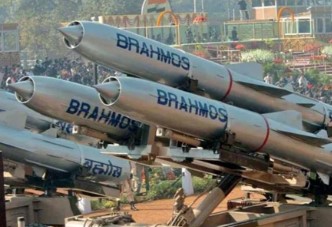India will deliver the third and final batch of powerful BrahMos supersonic cruise missiles to the Philippines. This move comes as tensions rise in the South China Sea, where China claims almost the entire area. The high-speed, long-range BrahMos missile will give the Philippines stronger defenses along its coast.
The Philippines signed a $375 million deal with India to buy three shore-based batteries of the BrahMos missile. India delivered the first set of missiles last year, and the Philippine Marine Corps has already deployed them. The second batch arrived earlier this year, in April 2025. India is expected to deliver the third batch soon, though it has not announced an exact date.
India’s BrahMos Missiles to Strengthen Philippines’ Defense
BrahMos missiles are designed to strike enemy ships at sea with incredible precision. The BrahMos can travel up to 290 kilometers at a speed of Mach 2.8, making it extremely fast and hard to intercept. Its 200-300 kilogram warhead can destroy moving targets such as warships. This makes it an important tool for defending against threats in areas like the Scarborough Shoal and the Spratly Islands—places where the Philippines and China have often clashed.
The mobility of the missile launchers also adds to their strength. The Philippines can move the batteries to different locations across its coast, allowing its forces to respond faster in times of danger. The Philippine Marine Corps’ Coastal Defense Regiment will operate these systems to safeguard vital waterways and military posts.
China unveils YJ-12 Mach-6 missile drawing direct comparisons with India’s BrahMos
China strongly opposed this development. It called the deal a provocative action and warned that it could lead to an arms race. When India delivered the first batch of missiles, China formally objected. Beijing also raised complaints when India sent the second batch, accusing the Philippines of increasing tensions in disputed waters. Chinese authorities criticized the Philippines for building missile bases and called the move a challenge that could lead to dangerous misunderstandings.
Despite the protests, the Philippine government continues to view the BrahMos as a crucial part of its defense strategy. The government expects the missiles to boost coastal security and make it harder for hostile forces to challenge the country’s territory.
BrahMos and U.S. Systems Join Forces in Japan
The Philippines is not the only country strengthening its military. Japan and the United States are also deploying advanced missile systems China opposes. Their joint exercise, “Resolute Dragon,” began on September 11, 2025, and will run for two weeks.
The drills use Japan’s Type 12 missiles and the U.S. systems NMESIS and Typhon to create layered defenses for sea routes, coasts, and strategic areas. The Typhon Mid-Range Capability (MRC) system is especially powerful, with four launchers that can fire 16 missiles before reloading. It is mobile and can be deployed on land.
Strategic Boost to Indo-Filipino Defense Relationship Amid Heightened Tensions in South China Sea
Typhon can launch SM-6 missiles for air and sea threats up to 200 km away and Tomahawk missiles with a range of up to 1,600 km, allowing strikes on distant targets like military bases and ships. It will be stationed at Marine Corps Air Station Iwakuni in Honshu, though live firing during the exercise is uncertain.
China strongly opposed the deployment, urging the U.S. and Japan to consider regional security concerns and avoid escalating tensions.
NMESIS: A New Challenge for Naval Power
The second U.S. missile system being deployed is called NMESIS (Navy-Marine Expeditionary Ship Interdiction System). Unlike heavier and static defense systems, NMESIS is small, mobile, and easy to move quickly.
The missile system, based on a truck platform, can launch sea-skimming missiles at naval targets from a distance of about 185 kilometers. It merges the strike power of the Naval Strike Missile with the mobility of an autonomous vehicle launcher. This allows it to be deployed quickly in emergencies.
The U.S. 3rd Marine Division, stationed in Okinawa, has been training with NMESIS since July 2025. The division operates along the first island chain—a line of islands stretching from Japan down to Southeast Asia—and is responsible for defending against threats in the Philippine Sea.
India Unleashes BrahMos-Powered Frigate ‘Tamal’ from Russia’s Kaliningrad
One of the key areas of focus is the Miyako Strait, near Okinawa. It’s a vital waterway for Chinese naval forces trying to access the Pacific Ocean. The NMESIS will boost defenses in such strategic locations by providing a quick and accurate response to potential threats.
Though China responded less aggressively to NMESIS compared to Typhon, some experts warned that the system could complicate any future military planning involving Taiwan.
The deployment of BrahMos missiles to the Philippines and U.S. systems like Typhon and NMESIS to Japan significantly increases military firepower in the Indo-Pacific region. Regional allies are taking these steps to protect their territories and sea lanes, even as China strongly objects to their actions.
